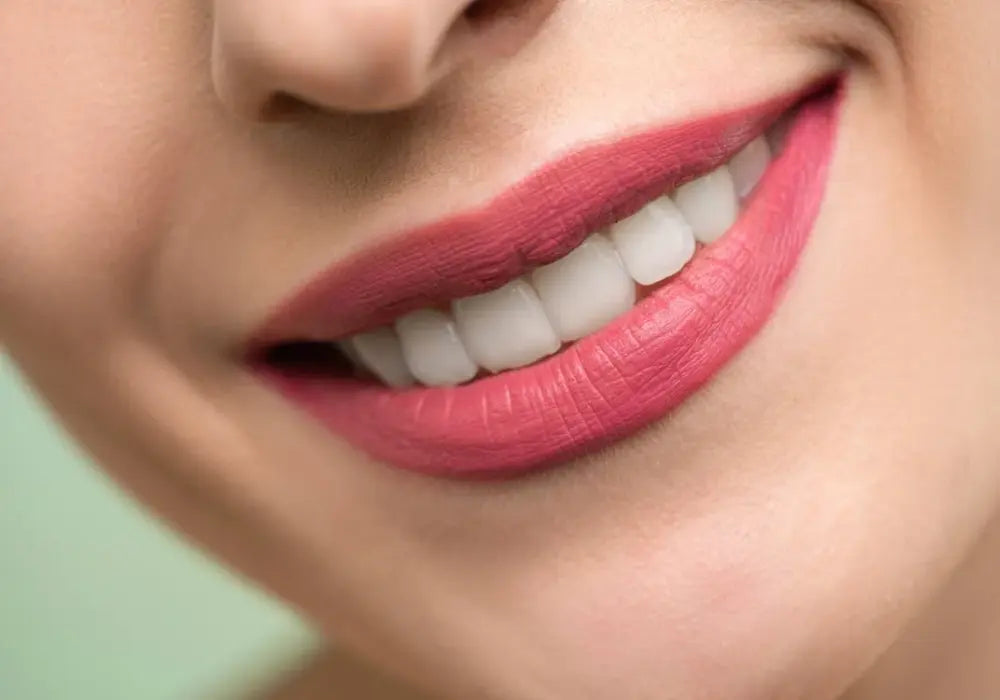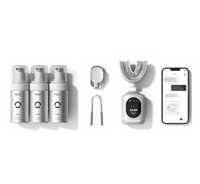
11 min read
Comparing Electric, Sonic, and Ultrasonic Toothbrushes: Which Is Right for You?
The journey from the humble beginnings of the manual toothbrush to today's advanced electric models encapsulates centuries of innovation aimed at improving oral health. Initially, toothbrushes were simple sticks chewed on one end to create a frayed cleaning surface. Modern technology has revolutionized this everyday tool, leading to the development of electric toothbrushes. Such innovations offer unique benefits and employ different technologies to cater to the diverse needs of dental hygiene.
What Are Electric Toothbrushes?
How Electric Toothbrushes Work
Designed to automate the brushing process using a motor to move the brush head in various patterns. Depending on the model, these movements can be oscillating, rotating, or pulsating. This automation helps in providing consistent brushing action that is often more effective than manual brushing, especially in terms of an electric toothbrush for plaque removal. The motor ensures that the bristles reach deeper between the teeth and along the gum line, providing a thorough clean that reduces the effort required by the user.
Types of Electric Toothbrushes
Rotating toothbrushes feature a brush head that turns in a circular motion while oscillating models have heads that move back and forth. Pulsating toothbrushes add an in-and-out motion that helps dislodge plaque and stimulate the gums. Each type offers unique benefits, and the choice often depends on personal comfort and specific dental health recommendations from oral health professionals.

Understanding Sonic Toothbrushes
How They Differ from Traditional Electric Brushes
Sonic toothbrushes employ a rapid side-to-side motion powered by high-frequency vibrations, creating a dynamic cleaning action. Unlike traditional electric toothbrushes, which rely more on mechanical rotation or oscillation, toothbrush technology utilizes sonic waves that can extend the cleaning effect beyond the actual contact points of the bristles. The sonic wave technology is also pivotal for deep cleaning toothbrushes. These waves cause vibrations in the fluid surrounding the teeth, which assists in breaking up plaque and bacteria even in areas the bristles might not touch directly. Such a phenomenon, known as fluid dynamics, ensures a thorough cleanse across the entire mouth, significantly enhancing gum health and reducing plaque buildup, crucial factors in preventing periodontal disease.
Benefits of Sonic Toothbrushes
The gentle vibrating action of the brush is effective yet soft on the gums, reducing gum inflammation and bleeding, which are common issues with manual or traditional electric brushes. For those with sensitive gums or gum disease, a sonic toothbrush for sensitive teeth can be particularly beneficial, promoting better oral hygiene without causing discomfort.
Features to Look For in Sonic Toothbrushes
Investing in a model with advanced settings and a durable design ensures a thorough cleaning while catering to specific dental needs. Below are some essential features to consider when selecting a sonic toothbrush that best suits your lifestyle and oral care goals:
- Adjustable Intensity Settings: Not everyone’s teeth and gums are the same—some users may have sensitive teeth that require a gentler touch, while others need a more vigorous cleaning to tackle stubborn plaque. Many models come with multiple intensity levels, ensuring that users can switch between modes based on their comfort and cleaning needs. Lower settings are ideal for individuals with receding gums or post-dental procedures, while higher intensities work well for those focusing on deep cleaning. Some innovative models can automatically adjust intensity based on pressure, preventing unnecessary gum damage.
- Timed Brushing Sessions: One of the most overlooked but crucial aspects of oral care is brushing for the right duration. Many people either rush through brushing or focus too much on certain areas while neglecting others. Sonic toothbrushes with built-in timers solve this issue by ensuring that you brush for the recommended two minutes. Some models even divide the time into 30-second intervals, reminding you to switch quadrants for a balanced clean. A structured approach prevents overbrushing in some spots and underbrushing in others, leading to more consistent results. Some advanced brushes come with customizable timer settings, allowing users to extend or shorten their brushing time depending on their needs.
- Long Battery Life: A long-lasting battery is essential for convenience, especially for frequent travelers or those who prefer minimal charging interruptions. Sonic toothbrushes vary widely in battery life, with some models lasting a few days and others capable of running for weeks on a single charge. Rechargeable lithium-ion batteries tend to provide the longest lifespan, reducing the need for frequent recharging. Some premium models offer fast-charging capabilities, allowing users to get a full charge in just a few hours. Certain brushes come with USB charging for added convenience, making them ideal for on-the-go use. A long battery life means fewer interruptions in your oral care routine, ensuring that you never miss a session due to a dead battery.
- Smart Features: Many sonic toothbrushes now come with Bluetooth connectivity, allowing users to sync their brushes with smartphone apps for real-time tracking and feedback. These apps provide insights into brushing habits, highlighting areas that may need extra attention while offering tips for improvement. Some high-tech models even feature AI-powered guidance, adjusting brushing patterns to optimize plaque removal. Certain smart toothbrushes also detect excessive pressure, warning users when they are brushing too hard, which helps prevent gum damage and enamel wear. Additionally, some models gamify brushing, rewarding users with points for completing proper routines—an excellent feature for encouraging children to maintain good oral hygiene. By selecting a sonic toothbrush with smart features, users can take advantage of personalized oral care recommendations, making their brushing routine both efficient and interactive.
- Quality of Bristles: The type and quality of bristles play a crucial role in ensuring effective cleaning while protecting the teeth and gums. Sonic toothbrushes should have high-density, soft bristles that can remove plaque without causing irritation or enamel erosion. Some advanced models feature tapered bristles, allowing deeper cleaning in hard-to-reach areas. Brushes with rounded bristle tips are especially beneficial for those with sensitive gums, as they provide gentle yet thorough cleaning. Some toothbrush heads also include multi-layered bristles designed to tackle different types of buildup, ensuring a more effective clean. Many modern sonic toothbrushes come with replacement reminders, signaling when to change the brush head.
- Ergonomic Design: An ergonomic handle ensures a secure grip, making brushing effortless—even for those with limited dexterity or grip issues. Many high-quality models feature rubberized grips to prevent slipping, while others have sleek, lightweight designs for comfortable handling. Some toothbrushes are designed with angled necks, allowing users to reach molars and other difficult-to-access areas without straining their wrists. A well-balanced toothbrush enhances brushing efficiency by minimizing hand fatigue, making it easier to maintain a consistent routine. Also, compact and lightweight designs are ideal for travelers, ensuring that oral hygiene is never compromised, even on the go.
By carefully evaluating these aspects, users can select a toothbrush that caters to their specific oral health needs, ensuring optimal plaque removal, gum protection, and overall dental hygiene. The right ultrasonic toothbrush benefits not only improves daily brushing habits but also enhances long-term oral health, making it a worthwhile investment.
Choosing the Best Toothbrush for Your Needs
Best Toothbrush for Whitening Teeth
For individuals looking to enhance the whiteness of their teeth, a toothbrush for sensitive gums incorporates technology that can tackle surface stains effectively. Sonic and ultrasonic toothbrushes are particularly adept at this, as their high-frequency vibrations are great for plaque removal and excel at breaking down stains on the enamel. When combined with whitening toothpaste, these toothbrushes can provide noticeably brighter teeth over time without the harsh abrasives that some manual brushing methods might employ.
U-Shaped and Mouth-Shaped Toothbrushes
Mouth-shaped and U-shaped toothbrush designs are innovative alternatives to traditional toothbrushes. These models are designed to clean all teeth simultaneously, with bristles aligned in a U-shape or conforming to the mouth’s shape. They promise to reduce brushing time significantly while ensuring that all surfaces are brushed uniformly. While promising, these designs may not yet provide the personalized cleaning that some dental conditions require, making them a secondary option for those without special oral care needs.

Maintaining and Maximizing Your Toothbrush’s Effectiveness
How to Properly Clean and Store
Maintaining your toothbrush's cleanliness and proper storage is essential for ensuring its effectiveness and longevity. The accumulation of bacteria on a toothbrush can counteract the benefits of brushing, introducing old bacteria back into your mouth. Here are detailed steps and best practices to ensure your toothbrush is well-maintained:
- Rinse Thoroughly: After each use, it’s important to rinse your toothbrush under warm running water to remove leftover toothpaste, food particles, and bacteria. Simply shaking the bristles underwater isn’t enough; you should ensure that all visible debris is gone by running your fingers through the bristles if necessary. Warm water is preferable because it helps loosen and wash away stubborn particles more effectively than cold water. If toothpaste residue and plaque remain on the toothbrush, it can harden over time, making the bristles less effective and increasing the risk of bacterial buildup. A clean toothbrush ensures that each brushing session removes plaque without reintroducing old bacteria into your mouth.
- Shake Off Excess Water: Vigorously shaking off any excess water is an essential step after thoroughly rinsing. Retained moisture creates an environment where bacteria and mold thrive, reducing the effectiveness of your toothbrush. Microorganisms flourish in damp conditions, so eliminating as much water as possible is a simple yet crucial habit to develop. If possible, use a clean towel to pat the handle dry, further reducing moisture gently. Water buildup at the bristle base can promote the growth of bacteria that are not detected until later use.
- Store Upright: Proper storage plays a significant role in maintaining your toothbrush’s hygiene. Storing it upright, such as in a cup or designated toothbrush holder, allows air circulation to speed up drying. Laying a toothbrush flat on a surface can cause moisture to pool at the bristles, promoting bacterial growth and mildew. When multiple toothbrushes are stored together, keeping them upright prevents the bristles from touching, reducing the risk of cross-contamination between different brushes. Whether using a holder attached to a wall or a traditional stand, ensuring that your toothbrush remains elevated helps maintain its cleanliness between uses.
- Avoid Covers for Daily Use: While covering your toothbrush may seem like a protective measure, it often does more harm than good. A cover traps moisture inside, creating a warm, humid environment that fosters bacterial growth rather than preventing it. This is especially true if the toothbrush is stored while still damp, as the enclosed space encourages bacterial colonization on the bristles. If you must use a cover while traveling, ensure the toothbrush is completely dry before enclosing it. Opting for a ventilated cover or case can allow for some air circulation while still protecting from contaminants. However, for everyday storage at home, leaving the toothbrush exposed to open air is the best approach to maintaining hygiene.
- Keep It Separate: Avoiding direct contact between toothbrushes is vital for preventing cross-contamination. Storing multiple ultrasonic toothbrush cleaning power too close together can transfer bacteria from one brush to another, potentially spreading harmful germs. This is particularly important if someone in the household is sick, as bacteria and viruses can linger on toothbrush bristles and easily spread from person to person. Using separate holders or individual slots in a toothbrush stand can help keep brushes safely apart. If storing toothbrushes in a shared bathroom, ensure they are placed in an open space with proper airflow to prevent microbial buildup. Keeping toothbrushes isolated from one another is an essential step in maintaining good oral hygiene.
- Deep Clean Regularly: Besides daily rinsing, a more thorough cleaning routine is recommended to remove lingering bacteria. Once a week, soaking the toothbrush in antibacterial mouthwash or a hydrogen peroxide solution for a few minutes helps kill any accumulated germs. Another effective method is UV sanitizer, which can eliminate bacteria with light-based technology. For those preferring a more natural approach, soaking the bristles in vinegar and baking soda is a chemical-free way to disinfect the toothbrush. Regardless of the method, deep cleaning ensures that bacteria and debris do not accumulate over time, keeping the toothbrush as hygienic as possible.
Following these steps helps prevent bacterial buildup, prolongs the lifespan of your ultrasonic toothbrush for gum disease, and ensures that every brushing session is as practical as possible.
When to Replace Your Brush Head
Dentists universally recommend replacing your toothbrush head every three to four months. Frequent replacements are necessary because worn-out bristles lose their effectiveness in removing plaque and bacteria. Moreover, damaged bristles can be harsh on gums and may lead to irritation or damage. Watching for signs of wear and ensuring timely replacement can keep your toothbrush's performance at its peak and safeguard your dental health.

Toothbrushes best for gum health can significantly improve oral hygiene by providing a more effective and consistent cleaning experience than manual alternatives. Whether choosing a traditional rotating model or an ultrasonic toothbrush, selecting the right features ensures a tailored approach to dental care.
Share




